The renovations at Epiphany Cathedral in Venice are making great progress with significant milestones reached in recent months.
Bishop Frank J. Dewane, joined by Diocesan Chancellor Dr. Volodymyr Smeryk and Msgr. Patrick Dubois, Cathedral Rector, took a tour of the construction site on Aug. 28, 2025. The tour was part of a regularly scheduled contractor update to review the progress of the work and to address any issues.
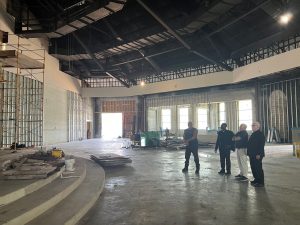
Bishop Dewane expressed his pleasure at the progress of the work, which addressed many of the structural needs that required the work to be done in the first place, as well as forming the renovated building to conform to the liturgical and pastoral needs of a Cathedral.
As a Cathedral is considered the “Seat of the Bishop,” many Diocesan-wide Masses are held there, such as the Chrism Mass where the Bishop blesses the Holy Oils used by Parishes for sacramental needs throughout the Diocese all year, the Rite of Election where the Bishop welcomes candidates for entry into the faith, the ordination of priests, the ordination of permanent deacons, and much more.
Epiphany was originally built as a Parish church and not as the “Seat of the Bishop.” With the building showing its age with water leaks, electrical outages, crumbling walls, sinking floors, and a cracked foundation, a major renovation was the best and most practical way to not only repair the church, but create a proper Cathedral.
Within the past month, significant project milestones have been reached: hurricane-proof windows have been installed, the scratch brown coat of plaster has been completed on the exterior walls, the concrete slab throughout the building has been poured and finished, and the interior ceiling layout finalized. The roof is expected to be completed in a few months. Inside, the wall near the sanctuary is already being built and will soon serve as the foundation for a magnificent Epiphany mosaic scene.
With the installation of the hurricane windows, the Cathedral is protected should a storm threaten. This has addressed one of the preeminent concerns of Bishop Dewane as the work has progressed. Temporary barrier walls were in place during the destructive 2024 hurricane season.

Bishop Dewane was also able to see sample representations of the ceiling for the sacristy as well as what the stained-glass windows will look like when they are installed closer to the completion of the building. The glass reflects the major themes which were present in the Cathedral before the renovation. The original windows, which were made of glass embedded in a concrete frame, were not salvageable and required extensive repairs and maintenance through the years. Of note, the donors who contributed to the former windows will be honored on the new windows.
More of the interior’s transformation will include a new, semi-circular sanctuary with the Cathedral’s Tabernacle at its center and a beautiful, custom mosaic behind it, brand new pews, and gleaming marble flooring throughout.
Viewed from the exterior, many of the main elements have been completed. The new barrel-roofed, extended Narthex immediately signals that one has entered a sacred space of importance. Inside the main worship space, the soaring ceiling height inspires awe, and will eventually be a beautiful wooden, Cathedral-height ceiling, which will add warmth to the great space. Expansion for an additional 300 seats and more parking spaces means the Diocesan-wide Masses held at the Cathedral will easily accommodate those who travel from other Parishes to participate.
Outside, a 75-foot double-bell tower with real Church bells will replace the current electronic bell system and will bring the clarion cry of authentic Church bells to downtown Venice, calling all to worship, and prayer. That work will come closer to the conclusion of the project.
The Memorial Garden, which sits on the southeast corner of the Cathedral, is intact and has been preserved to be incorporated in the updated design of the project. Among other improvements, the garden will receive new fencing and a statue of the Pieta.

Msgr. Dubois said he is delighted that the renovations at Epiphany Cathedral are progressing beautifully. He is deeply thankful to Bishop Dewane for his constant paternal encouragement and leadership, which provides strength as the project moves forward.
“God’s providential hand also guides the Cathedral’s renovation,” Msgr. Dubois said. “That is why we cannot but be truly grateful to the parishioners of Epiphany, as well as to many beyond our Parish, for their generosity, their patience, prayers, and their steadfast support during this time of waiting…As we move forward, let us look ahead with ever renewed hope and joy to that day when we return to our renewed Cathedral, giving thanks to God who ‘makes all things new’ (Revelation 21:5).”
The Diocese of Venice is funding 50% of the project’s cost. Epiphany Cathedral’s parishioners, and contributions from all the other Diocesan Parishes combined, will cover the remainder of the cost.
To learn more about the differences between a Cathedral and a Parish Church, and for regular renovation updates, visit: www.epiphanycathedral.org/renovation.
To donate to the Epiphany Cathedral project, please visit www.epiphanycathedral.org/capital-campaign.






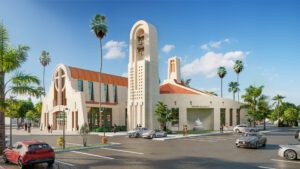
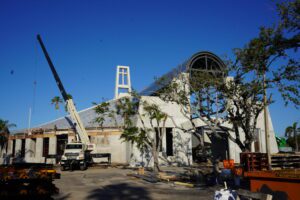
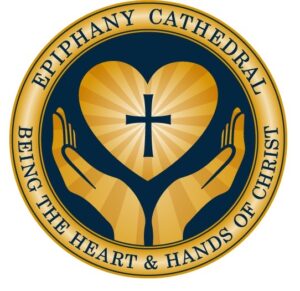



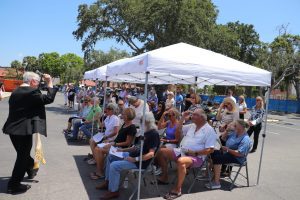
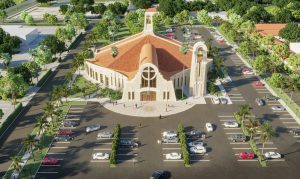
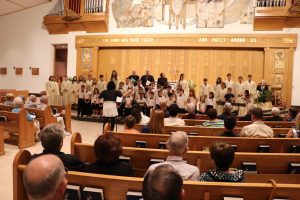 Here in the Diocese of Venice, Bishop Frank J. Dewane hosts an annual interreligious gathering of Yom HaShoah: An Hour of Remembrance. This year the event was held on April 15 at Epiphany Cathedral, Venice, just a few days after April 11, the traditional Remembrance Day.
Here in the Diocese of Venice, Bishop Frank J. Dewane hosts an annual interreligious gathering of Yom HaShoah: An Hour of Remembrance. This year the event was held on April 15 at Epiphany Cathedral, Venice, just a few days after April 11, the traditional Remembrance Day.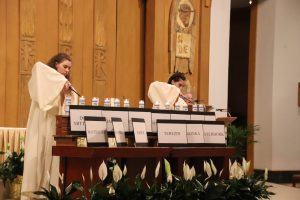 Afterwards the guests went to a reception in the Parish Hall where there were also displays of research projects done by middle schoolers from Epiphany Cathedral and St. Martha Catholic schools. These covered topics of research on the stories of those whose lives were taken too soon, or of the incredible story of survivors.
Afterwards the guests went to a reception in the Parish Hall where there were also displays of research projects done by middle schoolers from Epiphany Cathedral and St. Martha Catholic schools. These covered topics of research on the stories of those whose lives were taken too soon, or of the incredible story of survivors.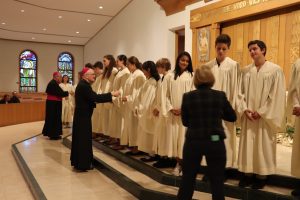 Bishop Dewane spoke briefly about the need for such gatherings which bring together members of the Catholic and Jewish communities to recommit to the promotion of peace and solidarity among all peoples.
Bishop Dewane spoke briefly about the need for such gatherings which bring together members of the Catholic and Jewish communities to recommit to the promotion of peace and solidarity among all peoples.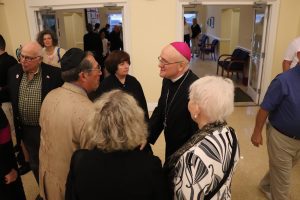 One way to help avoid this is the ongoing effort of the Catholic Schools in the Diocese to have comprehensive program to educate middle and high school students on the Holocaust through various means, explained Dr. Kristy Swol, Diocese Director of Education. “It is hoped that by learning about the Holocaust, they learn about the past and also how to protect the future,” Swol concluded.
One way to help avoid this is the ongoing effort of the Catholic Schools in the Diocese to have comprehensive program to educate middle and high school students on the Holocaust through various means, explained Dr. Kristy Swol, Diocese Director of Education. “It is hoped that by learning about the Holocaust, they learn about the past and also how to protect the future,” Swol concluded. Bishop Massa spoke about the need to properly develop one’s conscience to respond to injustices such as the Holocaust. Using the example of the White Rose Society, a group of university students who were publicly against the atrocities that the Nazi regime and did so by distributing leaflets at their school and throughout Munich, Germany in early 1943.
Bishop Massa spoke about the need to properly develop one’s conscience to respond to injustices such as the Holocaust. Using the example of the White Rose Society, a group of university students who were publicly against the atrocities that the Nazi regime and did so by distributing leaflets at their school and throughout Munich, Germany in early 1943.